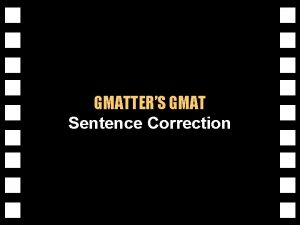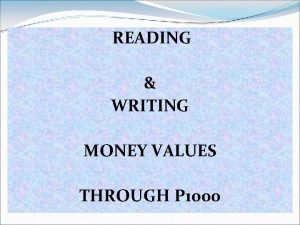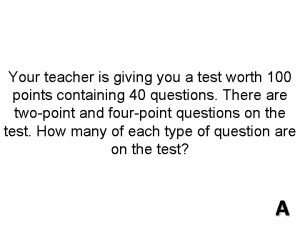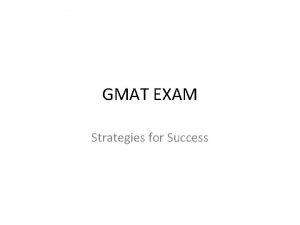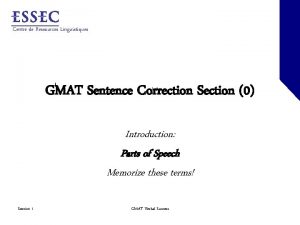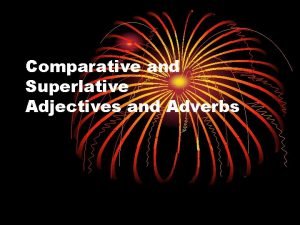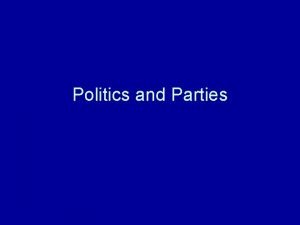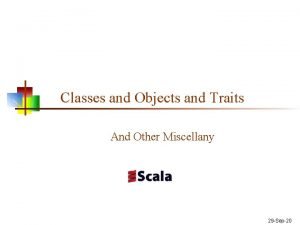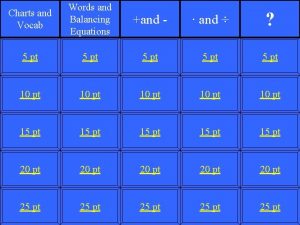THE GMAT What is the GMAT and how




















































- Slides: 52

THE GMAT • What is the GMAT and how is it used? • What does the test involve? • How can you best prepare?

Part One What is the GMAT and how is it used?

The basics • What GMAT means • How the GMAT may be used – by schools • one of several metrics • test of character – by you • application • CV • learning

Part Two What does the test involve?

Test overview • • • Essay (AWA) ~ 30 minutes Integrated Reasoning ~ 30 minutes 8 minute break Quant ~ 75 minutes 8 minute break Verbal ~ 75 minutes

The less important bits 1 • Analytical Writing Assessment – importance – how to ace it • template • keep it simple • be clear & concise – preparation • planning – timing • plan, write, review

The less important bits 2 • Integrated Reasoning – importance 1. according to GMAC 2. according to schools & tutors – preparation • question types • synthesising information – timing – all multiple choice

The less important bits 3 • Do – stay calm ~ you know what to expect – keep it simple (AWA) – do what you can (IR) • Don’t – take them too seriously – show off (AWA) – worry about getting everything right (IR)

Your mission in the first hour is… Be fresh and focused for Quant and Verbal!

Quant overview • 37 questions – almost exactly 2 mins per question made up of… • 22 Problem Solving (normal Maths) • 15 Data Sufficiency – same theory, different format

Verbal overview • 41 questions – a little less than 2 mins per question • Sentence Correction – correcting grammar and style • Critical Reasoning – a question about an argument • Reading Comprehension – what it sounds like

N. B. • In both sections, question types are mixed up • All questions are multiple choice (A-E)

Problem Solving 1 The two big areas of theory are. . Number Properties and Algebra

Problem Solving 2 Other reasonably important areas are. . Fractions & Percentages Powers & Roots Statistics Rate & Ratio Geometry

Problem Solving 3 And finally, don’t worry too much about. . Sequences Venn diagrams Coordinate geometry Functions Probability Combinatorics Symbolism

Data Sufficiency 1 • Requires same theory as Problem Solving • You are asked a question • You are given statements (1) and (2) • You decide whether the statements give sufficient information to answer the question

There are two types of questions…

Data Sufficiency 2 “What is the value? ” questions Example What is the value of x + y? (1) x = 3 and y = 5 (2) a = 2 and b = 1 We can answer with (1) but not with (2)

Data Sufficiency 3 A similar example What is the value of x + y? (1) x = 7 (2) y = 11 We need both statements together to answer the question; one statement on its own is not enough

Data Sufficiency 4 Yes / No questions Example Is x a prime number? (1) 6 < x < 8 (2) x has two factors Got an answer?

Data Sufficiency 5 Either statement on its own is sufficient to know that the answer is Yes

N. B. If a statement (or statements) is sufficient to give a definite answer of NO, that’s ok too

Sentence Correction 1 Theory required: Rules of (old-fashioned, formal, written) English grammar AND An understanding of (good) style in written English

Sentence Correction 2 Format: • You are given a sentence, some or all of which is underlined • You must replace the underlined portion with one of five options • Answer choice A is always the same, i. e. the sentence is correct as it stands

Critical Reasoning 1 Format: • You are given an argument. Arguments may contain the following: – Premise (fact) – Assumption – Conclusion (opinion) • You get a question on that argument – multiple choice answers

Critical Reasoning 2 Sample questions: • What would strengthen/weaken the argument? • On what assumption is the argument based? • What would help us to better evaluate the argument?

Reading Comprehension 1 Format: • You are given a passage of ~350 words • Any topic ~ no outside knowledge needed • You answer 3 (or sometimes 4) multiple choice questions

Reading Comprehension 2 Sample questions: • What is the primary purpose of this passage? • The author would most likely agree with which of the following statements? • Theory A differs from Theory B on which of the following points?

Part Three How can you best prepare?

What To Do 1 Quant first steps • Learn theory • Use a Maths book • Do one topic at a time • Practise processes until they become automatic

What To Do 2 OG questions • Start with the lower-numbered questions in each section as they’re easier (supposedly) • Work out what you don’t know, or can’t do, and then fix it

How To Do It 1 When you sit down to study, HAVE A LEARNING OBJECTIVE Never an amount of questions Never a set time By the end of this session… What do I want to have achieved? I want to be better at…. . what?

How To Do It 2 When going through the OG, DO EACH QUESTION (AT LEAST) 3 TIMES 1. Test conditions 2. Long as you like 3. Review (later)

How To Do It 3 REVIEW EVERYTHING! (especially when you’re tired after work ~ save new questions for when you’re fresher) FIND YOUR WEAKNESSES

Fixing it 1 I didn’t know what to do =( • Look for clues – Keywords – Answer choices • Compare similar questions

Fixing it 2 It took too long =( • Practise processes • Learn to read questions (clues / similar questions) • Find shortcuts • Just get the answer however you can!

Fixing it 3 I don’t understand this topic very well =( • • Go back to basics Work on one topic at a time Practise until you do understand Ask for help

Fixing it 4 I made a silly mistake =( • Work out why – copying error – going too quickly – messy working – misread the question • Always re-read the question!

Top tips 1 Have a timing strategy • Time as an investment ~ ROI • Faster and slower ~ what difference does it make?

Top tips 2 Use the answer choices • Issues • Similarities and differences • Clues, common elements

Top tips 3 Learn to eliminate wrong answers

Problem Solving skills • • • Multiplication and division Prime factorisation Identifying number properties Deriving algebraic equations Solving algebraic equations Applying formulae • Reading the question

Data Sufficiency skills • Being methodical • Finding a method that works for you

Sentence Correction skills • Applying rules of grammar • Spotting small differences • Developing an instinct for the sound of a sentence • Giving reasons why things that sound wrong are wrong

Critical Reasoning skills • Simplifying an argument – line of reasoning • Identifying premises, assumptions, conclusions, inferences etc. • Knowing what is ‘outside the scope’ • Clarifying the two sides of an argument – double negatives

Reading Comprehension skills • Speed reading • Summarising • Mind-mapping or other note-taking – descriptive vs argumentative • Identifying keywords • Recognising synonyms

Resources • • • GCSE level Maths book The Official Guide to GMAT Review A book on English grammar and style mba. com free software Other online resources e. g. khanacademy. org

More fun ways to prepare • • Sudoku Spot the difference Crosswords Card games Philosophy Old newspaper reports Numbers in everyday life

Deliberate mistake 1 Is x a prime number? (2) x has two factors Statement (2) is the definition of a prime number, therefore statement (2) is sufficient BUT…

Deliberate mistake 2 Is x a prime number? (1) 6 < x < 8 x does not have to be an integer, therefore statement (1) is NOT sufficient

Area 51 This is slide #51 What are the properties of 51?

Slide 52 51 = 3 x 17 (it has no other properties, so if 51 appears in a question it’s probably because it divides by 17) And 52? 52 = 2 x 26 52 = 4 x 13 (4 suits of 13 cards) etc.
 Gmat definition
Gmat definition Gmatter
Gmatter Gmat
Gmat Gmat
Gmat Hát kết hợp bộ gõ cơ thể
Hát kết hợp bộ gõ cơ thể Frameset trong html5
Frameset trong html5 Bổ thể
Bổ thể Tỉ lệ cơ thể trẻ em
Tỉ lệ cơ thể trẻ em Voi kéo gỗ như thế nào
Voi kéo gỗ như thế nào Tư thế worm breton
Tư thế worm breton Hát lên người ơi alleluia
Hát lên người ơi alleluia Các môn thể thao bắt đầu bằng tiếng bóng
Các môn thể thao bắt đầu bằng tiếng bóng Thế nào là hệ số cao nhất
Thế nào là hệ số cao nhất Các châu lục và đại dương trên thế giới
Các châu lục và đại dương trên thế giới Công của trọng lực
Công của trọng lực Trời xanh đây là của chúng ta thể thơ
Trời xanh đây là của chúng ta thể thơ Mật thư anh em như thể tay chân
Mật thư anh em như thể tay chân Phép trừ bù
Phép trừ bù Phản ứng thế ankan
Phản ứng thế ankan Các châu lục và đại dương trên thế giới
Các châu lục và đại dương trên thế giới Thơ thất ngôn tứ tuyệt đường luật
Thơ thất ngôn tứ tuyệt đường luật Quá trình desamine hóa có thể tạo ra
Quá trình desamine hóa có thể tạo ra Một số thể thơ truyền thống
Một số thể thơ truyền thống Cái miệng xinh xinh thế chỉ nói điều hay thôi
Cái miệng xinh xinh thế chỉ nói điều hay thôi Vẽ hình chiếu vuông góc của vật thể sau
Vẽ hình chiếu vuông góc của vật thể sau Thế nào là sự mỏi cơ
Thế nào là sự mỏi cơ đặc điểm cơ thể của người tối cổ
đặc điểm cơ thể của người tối cổ Giọng cùng tên là
Giọng cùng tên là Vẽ hình chiếu đứng bằng cạnh của vật thể
Vẽ hình chiếu đứng bằng cạnh của vật thể Tia chieu sa te
Tia chieu sa te Thẻ vin
Thẻ vin đại từ thay thế
đại từ thay thế điện thế nghỉ
điện thế nghỉ Tư thế ngồi viết
Tư thế ngồi viết Diễn thế sinh thái là
Diễn thế sinh thái là Dot
Dot So nguyen to
So nguyen to Tư thế ngồi viết
Tư thế ngồi viết Lời thề hippocrates
Lời thề hippocrates Thiếu nhi thế giới liên hoan
Thiếu nhi thế giới liên hoan ưu thế lai là gì
ưu thế lai là gì Sự nuôi và dạy con của hổ
Sự nuôi và dạy con của hổ Sự nuôi và dạy con của hươu
Sự nuôi và dạy con của hươu Sơ đồ cơ thể người
Sơ đồ cơ thể người Từ ngữ thể hiện lòng nhân hậu
Từ ngữ thể hiện lòng nhân hậu Thế nào là mạng điện lắp đặt kiểu nổi
Thế nào là mạng điện lắp đặt kiểu nổi Red orange yellow blue green purple
Red orange yellow blue green purple And because i am happy and dance and sing
And because i am happy and dance and sing Romeo and juliet vs west side story venn diagram
Romeo and juliet vs west side story venn diagram Taller and younger and shorter and older
Taller and younger and shorter and older How to write 25 centavos in symbol
How to write 25 centavos in symbol Blue indigo violet
Blue indigo violet Gabby and sydney bought some pens
Gabby and sydney bought some pens

